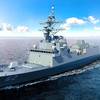Strained by the demands of a major ground war and a sweeping overhaul of U.S. forces for an uncertain future, the Pentagon faces a severe budget challenge. According to the Providence Journal, while Congress and the Bush administration are working on a very large spending program for the military, the outlay for shipbuilding will be tight -- a prospect that is hurting the industry.
The Navy's problem, says one Washington analyst, is not a lack of ships, but a lack of money to keep the shipbuilding industry moving.
Congress and the Bush administration are working on a very large defense spending blueprint for fiscal 2006, but it will continue a long string of tight shipbuilding budgets that are pinching the industry hard.
"The Navy is really in a pickle," according to another Washington analyst, Robert Work. "They don't necessarily need more ships, but they need more production to keep the shipbuilding industry in place. And how do you do that on $9 to $11 billion a year?"
Observers say that the shipbuilding budget will probably remain around $9 billion to $11 billion for the next several years, its level since early in the Bush administration.
Rep. James R. Langevin, a member of the House Armed Services Committee, said, "You really need to produce eight or nine ships each year just to maintain the current fleet."
But the House defense bill calls for "only four ships next year," said Langevin.
"The challenge for the Navy," said Ronald O'Rourke of the Congressional Research Service, "is how to adapt this transformation effort to the near-term operational demands associated with the global war on terrorism," plus such longer-term demands as "countering improved Chinese maritime forces."
Subscribe for
Maritime Reporter E-News
Maritime Reporter E-News is the maritime industry's largest circulation and most authoritative ENews Service, delivered to your Email five times per week










